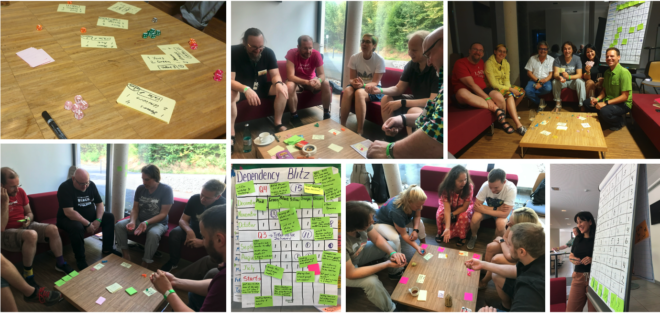Authors:
Dana Pylayeva, Ilja Vishnevski
Objective of the sport:
Find a golden path to delivering most enterprise worth by benefiting from collaboration vs. getting caught in dependencies.
Number of gamers: 4 – 6 gamers
Duration: 6- 12 rounds (60 – 90 min)
Game parts:
30 cube (6 totally different colors, 5 cube every)
1 facilitator die
36 problem playing cards (6 per every color)
12 bonus playing cards
1 Delivery board
Download and print the Challenge playing cards, bonus playing cards and the Delivery board.
Game setup:
- If there are lower than 6 gamers within the sport, take away additional colors (cube and corresponding color problem playing cards)
- Distribute the cube to the gamers, one color per participant.
- Place problem decks on the desk, face down and bonus card deck face up.
Round one:
- Set: Facilitator rolls the die to disclose the variety of dependencies that the gamers might want to work with within the first spherical. Players open up a corresponding variety of the problem playing cards, and place them on the desk face up.
- Plan: Players resolve whether or not they are going to be working individually, collaborate on addressing dependencies or cut up their capability, and try and do each.
- Run: Everyone rolls the cube on the identical time based on the plan.
- Calculate
- Individual work: Player will get 1 enterprise worth level for rolling “1” on any of his/her cube that had been allotted for this work.
- Challenge card: Group will get a full worth (5 or 8 enterprise worth factors) of the problem card that they had been capable of remedy on this spherical.
- Delivery board will get up to date with the outcomes and the gamers proceed with the subsequent spherical.
Note:
- Partially accomplished playing cards don’t earn worth and so they “lock up” the partially accomplished cube till dependency is totally solved.
- Challenge playing cards can have time bins (1 month, 3 months). If this card’s dependency is just not solved by the point field, the group begins to pay for the price of delay (detrimental worth of the cardboard) in every spherical, till solved.
- Challenge playing cards can signify technical dependencies (indicated by a capital T in a circle). When this dependency is solved, the gamers have a selection: to depend the worth towards the overall supply OR to trade it for one of many bonus playing cards.
Next rounds:
- Set: If there are present dependencies left on the desk from a earlier spherical, when a facilitator rolls the die, new dependencies are added provided that the quantity on the die is bigger than the variety of pre-existing dependencies.
- Plan: Players make plans on their capability allocation, realizing that some for his or her cube is perhaps “locked up” in {a partially} accomplished work from the earlier spherical.
- Run: Players roll the cube based on the plan
- Calculate: The enterprise worth factors are calculated (adjusted for the price of delay) and recorded within the present month column on the Delivery Board
Note:
- If this spherical corresponds to the top of March, June or September on Delivery Board, whole worth delivered is calculated for the quarter, and the workforce is invited to run a quarterly retro and planning. At this time they might select to drop any dependencies that they haven’t began by “paying” ½ of the cardboard worth, or drop any partially began dependencies by “paying” full worth of the cardboard.
- If that is the final spherical(December on the Delivery Board), the overall worth delivered is calculated for all the yr. When whole worth is calculated, the overall face values of any incomplete or partially full dependencies are deducted from the overall enterprise worth delivered by the workforce within the earlier 12 months.
Game debrief concepts:
- What did you discover in our manner of working? Our communication?
- How is that this related to your actual life dependency challenges?
- How did it really feel to work beneath time field stress?
- What insights have emerged for you throughout this sport?
Acknowledgement:
This sport emerged as an thought throughout a sport design pre-event facilitated by Tim Yevgrashyn & Katrin Elster on the Play4Agile 2022 convention. From an thought to a playable prototype, the sport advanced by means of speedy prototyping, each day (and night) play testing with the assistance, concepts, suggestions and cheers from the group of incredible agile sport designers, who I’m impressed by and really grateful to (in alphabetical order):
Marc Bless, Olaf Bublitz, Kurt Cotoaga, Martin Heider, Reinald Kirchner, Falk Kühnel, Michael Mahlberg, Christian Methfessel, Nastassia Krupiankova, Stanislava Potupchik, Markus Reinhold, Anja Steidl, Lucian Adrian Stroie, Adrian Suciu, Malte Sussdorff, Michael Tarnowski, Andreas Thier, Ilja Vishnevski, Silvana Wasitova, Tim Yevgrashyn.

What’s subsequent?
If you wish to get notified when a professionally printed Dependency Game is out there on The Gamecrafter, add your title to this mailing record.
If you might be glad to run it along with your groups in a DYI model, print the information, play and ship me your suggestions!
Dana Pylayeva is a world speaker, creator and an agile video games designer, creator of “DevOps with Lego and Chocolate”, “Fear within the Workplace”, “Safety within the Workplace” and “Dependency Game”.
Dana is an ICF Credentialed Professional Certified Coach (PCC), Scrum Alliance Certified Enterprise Coach(CEC), and Training from the Back of the Room Certified Trainer (TBR-CT).
She is captivated with unleashing management potential in people and groups. She brings a robust combo of a number of teaching kinds (Co-Active, Positive Intelligence, Executive Coaching), facilitation with Liberating Structures, deep data of Agile and DevOps house in addition to a breadth of expertise working with distant groups and worldwide shoppers (US, Canada, UK, Ireland, Japan, India and so forth).

